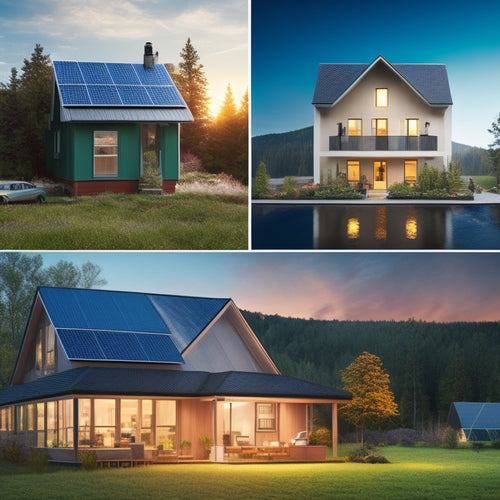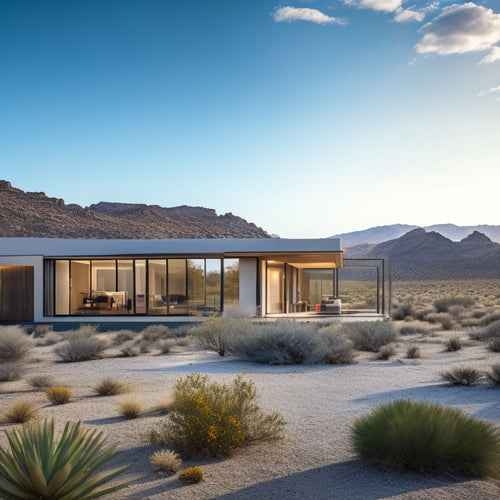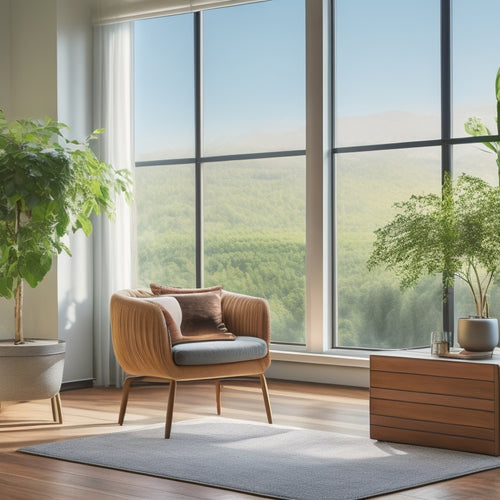
Why Upcycle Furniture for Energy-Smart Home Makeovers?
Share
By upcycling furniture, you're not only preserving natural resources and reducing waste, but also creating unique pieces that reflect your personal style and values. This eco-friendly approach to home makeovers decreases the demand for new, resource-intensive furniture, which greatly contributes to environmental degradation. Plus, upcycling is budget-friendly, allowing you to refresh your space without breaking the bank. As you investigate this innovative approach, you'll uncover how it not only benefits the planet but also supports local communities, preserves cultural heritage, and enhances your creative expression - and that's just the beginning of your energy-smart home renovation expedition.
Key Takeaways
- Upcycling furniture reduces waste, conserves resources, and promotes an energy-smart home by decreasing demand for new, resource-intensive furniture.
- It provides a budget-friendly way to refresh spaces through imaginative repurposing, affordable updates, and rethinking layouts without new purchases.
- Upcycled pieces offer unique personalization, creative expression, and one-of-a-kind style statements that reflect individuality and values.
- By incorporating eco-friendly solutions, upcycling enhances sustainability in home design, reducing utility costs and benefiting the environment.
- It supports local economies, preserves cultural heritage, and fosters community bonds through the reuse and repurposing of existing materials.
Reduces Waste and Conserves Resources
By upcycling furniture, you're actively reducing waste and conserving resources, an essential step towards an energy-smart home makeover.
This approach not only helps the environment but also promotes sustainable practices in your daily life. By choosing to upcycle, you're taking control of your resource management, making conscious decisions about the materials you use and the waste you produce.
This mindset shift can have a significant impact on the environment, as it reduces the demand for new, resource-intensive furniture.
Additionally, incorporating renewable energy solutions, such as solar energy implementation, can further minimize your carbon footprint.
By embracing upcycling, you're contributing to a more circular economy, where waste is minimized, and resources are valued.
This approach allows you to live more freely, knowing you're making a positive impact on the planet.
Unique Pieces for Personalized Spaces
You're looking for unique pieces that reflect your personality and style, and upcycling offers a wealth of one-of-a-kind finds.
By repurposing vintage or discarded items, you can create eclectic style statements that set your space apart.
Regular maintenance and inspections electrical connections are essential to guarantee that your upcycled furniture pieces operate within peak energy parameters.
Whether it's a refurbished mid-century modern armchair or a converted industrial pipe shelving unit, these distinctive pieces will make your home truly personalized.
One-of-a-Kind Finds
How do you find the perfect conversation starter for your living room? By upcycling one-of-a-kind vintage treasures, you can create a unique piece that reflects your personal style.
With a little creativity and some DIY techniques, you can convert an old, discarded item into a functional work of art. As you consider sustainable design options, remember that fast charging infrastructure can also be integrated into your home makeover.
Plus, incorporating energy-efficient solutions can lower operational costs and enhance energy independence. Scour thrift stores and flea markets for hidden gems that catch your eye.
Think outside the box when it comes to repurposing an item - an old door can become a coffee table, or a vintage window can become a mirror. Get creative with paint and stain to give your piece a fresh new look.
Add some personal touches, like decoupage or upholstery, to make it truly one-of-a-kind.
Eclectic Style Statements
As you venture into the world of upcycling, you'll reveal that eclectic style statements can change your space into a true reflection of your personality.
You'll realize that unique, one-off pieces can add a layer of depth and character to your home. By combining colorful patterns, texture combinations, and unconventional materials, you can create a space that's authentically yours.
Upcycled furniture becomes a form of self-expression, allowing you to break free from mass-produced designs and forge your own path.
With eclectic style statements, you're not limited by traditional design rules, giving you the freedom to experiment and push boundaries.
The result is a space that's truly yours, where every piece tells a story and reflects your individuality.
Budget-Friendly Home Decor Options
Five key areas to focus on when examining budget-friendly home decor options for your energy-smart makeover are repurposing, refinishing, restyling, rearranging, and rethinking.
These strategies will help you achieve affordable aesthetics without breaking the bank. You'll be surprised at how creative you can be with what you already have.
As you rethink your layout, consider incorporating eco-friendly stops with solar canopies and rainwater systems for sustainability sustainable road trip amenities and investigate ways to shift to renewable energy sources like wind, hydro, and geothermal energy.
- Repurpose old furniture: Think beyond its original function and imagine new uses.
- Shop second-hand: Thrift stores, garage sales, and online marketplaces are goldmines for unique finds.
- Get crafty: Update old pieces with a fresh coat of paint, new hardware, or reupholstery.
- Rethink your layout: Rearrange your space to create a fresh, functional flow.
Environmental Impact of New Furniture
When you buy new furniture, you're not just adding a new piece to your home - you're also contributing to a larger environmental impact.
New furniture production requires significant resources, leading to resource depletion and a substantial carbon footprint.
Carbon Footprint Matters
By choosing to buy new furniture, you're not only draining your bank account, but also contributing to the staggering environmental footprint of the furniture industry.
The production and distribution of new furniture require massive amounts of energy, which leads to greenhouse gas emissions and climate change. Furthermore, the reliance on non-renewable energy sources for manufacturing and transportation further exacerbates the issue Electrification of Industry.
Furniture production accounts for 3.5% of global greenhouse gas emissions.
Deforestation for wood sourcing contributes to biodiversity loss.
Furniture transportation leads to air pollution and congestion.
Landfills are overflowing with discarded furniture, taking centuries to decompose.
Resource Depletion Concerns
The environmental cost of new furniture goes beyond carbon emissions; it also depletes the world's natural resources at an alarming rate.
When you buy new furniture, you're contributing to the harvesting of wood, mining of metals, and extraction of other raw materials. This not only harms the environment but also perpetuates unsustainable practices.
By choosing upcycled furniture, you're adopting ethical consumption habits that reduce the demand for resource-intensive manufacturing. You're promoting sustainable practices that conserve natural resources for future generations.
Waste Generation Issues
You're likely unaware of the staggering amount of waste generated by the furniture industry. The production and disposal of new furniture contribute considerably to the growing problem of waste management. This issue is further exacerbated by the "take, make, dispose" approach that dominates the industry.
Here are some alarming facts about the environmental impact of new furniture:
-
Landfill waste: The furniture industry generates about 12 million tons of waste annually, with most of it ending up in landfills.
-
Resource consumption: Producing new furniture requires massive amounts of energy, water, and raw materials, contributing to resource depletion.
-
Greenhouse gas emissions: The manufacturing process releases considerable amounts of greenhouse gases, contributing to climate change.
- Waste management strategies: The industry's lack of sustainable consumption practices and waste management strategies only worsens the problem.
Creative Expression and Self-Identity
As you commence on an upcycling journey, this creative outlet becomes an extension of yourself, allowing your personality to shine through in every refurbished piece.
You're not just revamping old furniture; you're crafting a reflection of your unique style and viewpoint. Upcycling gives you artistic freedom to experiment, innovate, and tell your personal story through design.
Each piece becomes a proof of your creativity, values, and experiences. By upcycling, you're breaking free from the constraints of mass-produced furniture, embracing individuality, and injecting your space with character.
Your refurbished pieces become a conversation starter, revealing dimensions of your personality and sparking connections with like-minded individuals.
Energy Efficiency in Home Design
As you design your energy-smart home, you're not just creating a space that's good for the planet - you're also saving yourself money on utility bills.
By incorporating green building practices, like passive solar design and natural ventilation, you'll reduce your reliance on fossil fuels and lower your carbon footprint.
Green Building Practices
By incorporating energy-efficient design elements into your home makeover, you'll not only reduce your carbon footprint but also save on energy bills in the long run.
This is where green building practices come in. They're all about creating a sustainable and eco-friendly living space that not only benefits the environment but also your wallet.
Here are some ways to incorporate green building practices into your home makeover:
-
Opt for natural lighting: Instead of relying on artificial lighting, design your space to let in as much natural light as possible.
-
Use passive heating and cooling: Make the most of your home's natural insulation and orientation to reduce the need for heating and cooling systems.
-
Invest in energy-efficient appliances: Choose appliances with high energy efficiency ratings to reduce your energy consumption.
- Incorporate sustainable sourcing: Look for materials that are sourced sustainably and locally to reduce transportation emissions and support the local economy.
Eco-Friendly Materials Matter
You've taken the first step towards an energy-smart home makeover by incorporating green building practices.
Now, it's time to focus on eco-friendly materials that'll take your project to the next level. Sustainable sourcing is key – look for materials that are locally sourced, recycled, or reclaimed. This reduces carbon emissions and supports the local economy.
When it comes to finishes, opt for natural ones like wood, bamboo, or low-VOC paints. These not only promote a healthier indoor environment but also add a touch of elegance to your space.
Quality and Durability of Upcycled
While scouring thrift stores or grandma's attic for that perfect upcycling project, one essential aspect often gets overlooked: the quality and durability of the original piece.
You want to verify that the upcycled furniture benefits you'll reap are long-lasting and worthwhile. When selecting a piece, look for sturdy construction, solid wood, and well-made joints. Avoid flimsy or broken items that mightn't withstand the upcycling process.
Here are some key factors to take into account:
- Original material quality: Is the material durable and long-lasting?
- Construction and craftsmanship: Was the piece well-made to begin with?
- Condition and wear: How much wear and tear has the piece already endured?
- Potential for refurbishment: Can the piece be easily restored or refinished?
Supports Local Communities and Economy
As you begin on upcycling projects, you're not only giving new life to discarded items but also supporting local communities and economies.
By sourcing materials from local thrift stores, flea markets, or online marketplaces, you're investing in community engagement and economic sustainability.
You're creating a ripple effect that benefits local businesses and promotes a culture of reuse and recycling. This approach helps to strengthen community bonds and nurtures a sense of satisfaction in preserving the local heritage.
Reduces Carbon Footprint at Home
Upcycling furniture is a clever way to slash your carbon footprint at home, and it starts with a simple calculation: every reclaimed piece reduces the demand for new, resource-intensive furniture.
By choosing upcycled furniture, you're making eco-conscious choices that contribute to sustainable practices. Here's how you'll benefit:
-
Conserve natural resources: Upcycled furniture reduces the need for logging, mining, and other resource-extractive processes.
-
Lower energy consumption: Producing new furniture requires significant energy; upcycling eliminates this demand.
-
Reduce waste and pollution: Keeping old furniture out of landfills and incinerators helps minimize waste and pollution.
- Support a circular economy: Upcycling promotes a closed-loop system where materials are continuously reused and recycled.
Preserves History and Cultural Heritage
One piece of upcycled furniture can hold a wealth of stories and history. When you choose to upcycle, you're not just giving old furniture a new life; you're preserving heritage and cultural significance.
By reusing and repurposing, you're honoring the history behind each piece, keeping memories alive, and passing them down to future generations. Upcycling is a form of heritage preservation, allowing you to connect with your roots and community.
It's a way to celebrate cultural diversity, embracing the unique stories and traditions that make your home truly yours. By upcycling, you're not only reducing waste but also preserving the past, making it an integral part of your energy-smart home transformation.
Frequently Asked Questions
How Do I Find the Right Upcycled Furniture for My Home Decor Style?
You'll find the perfect upcycled furniture by scouting local thrift stores, online marketplaces, and DIY workshops that align with your upcycled aesthetics. Then, refine your furniture sourcing skills by considering scale, material, and functionality to guarantee a seamless fit with your home decor style.
Can I Upcycle Furniture Myself or Do I Need Professional Help?
You can definitely upcycle furniture yourself with some DIY techniques and the right Upcycling tools; however, if you're short on time or lack experience, consider hiring a pro to guarantee a high-quality, eco-friendly result that suits your style.
Are Upcycled Furniture Pieces Difficult to Maintain and Clean?
You'll be thrilled to know that upcycled furniture pieces can be a breeze to maintain and clean with the right cleaning techniques and maintenance tips, allowing you to enjoy your eco-friendly creations without the hassle!
Can I Upcycle Antique or Family Heirloom Furniture Pieces?
You can definitely upcycle antique or family heirloom furniture pieces, but first, research antique restoration techniques and heirloom preservation tips to guarantee you're honoring their history while giving them a modern, eco-friendly twist that still screams freedom and innovation.
Will Upcycled Furniture Negatively Impact My Home's Resale Value?
You cleverly refashion vintage gems, but wonder if they'll charm potential buyers; fret not, upcycled furniture can actually enhance your home's appeal in the resale market, as eco-conscious buyers perceive it as a unique, innovative selling point.
Related Posts
-

What Does Your Home Energy Audit Report Reveal?
Your home energy audit report reveals a detailed analysis of your energy consumption patterns, highlighting areas of ...
-

7 Best Geothermal Cooling Systems for Hot Climate Homes
You're evaluating geothermal cooling systems for your hot climate home, and you want to know the top options. Look fo...
-

7 Smart Air Purification Hacks for Energy-Savvy Homes
You can notably improve your indoor air quality while minimizing energy consumption by implementing strategic air pur...


